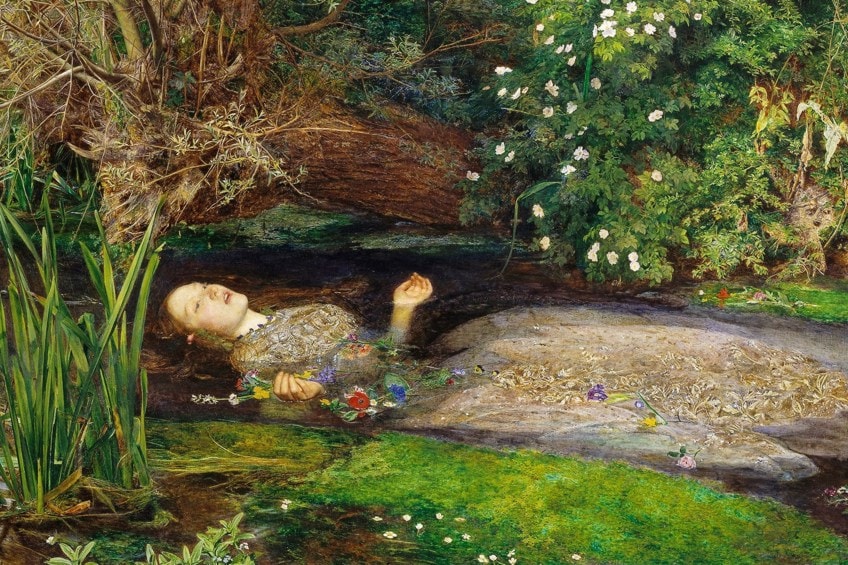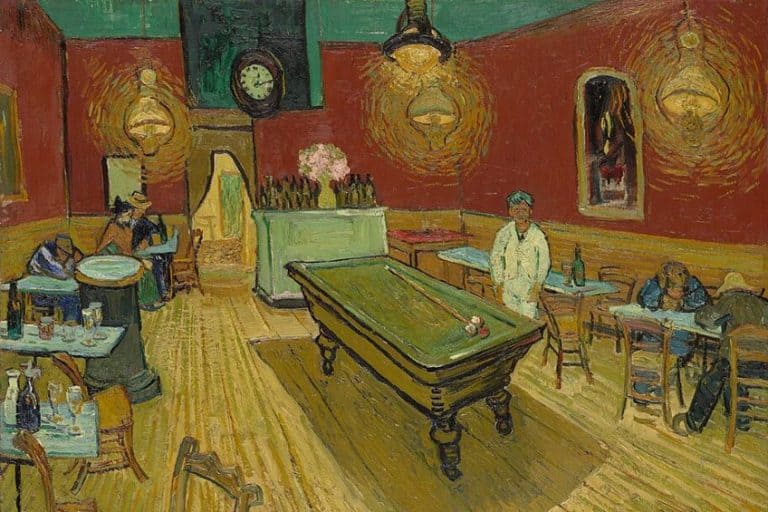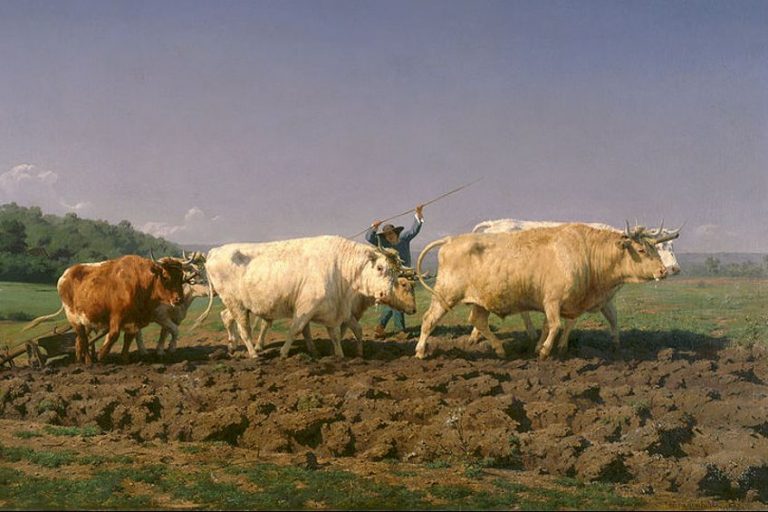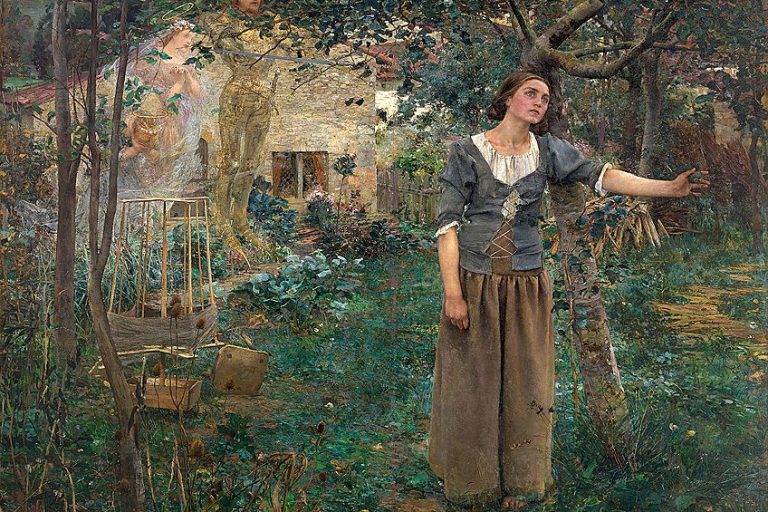“Ophelia” by John Everett Millais – The Tragic Story of Ophelia
William Shakespeare’s Hamlet (c. 1599–1601) was a tale of love, murder, madness, and heartbreak, of which the character Ophelia met her end, drowning in a brook, but is forever immortalized in the visual arts. In this article, we will discuss one of the most famous renditions of her tragic end by pre-Raphaelite artist John Everett Millais.
Artist Abstract: Who Was John Everett Millais?
Sir John Everett Millais was born on June 8, 1829, and died on August 13, 1896. He was one of the leading artists and founders of the pre-Raphaelite Brotherhood group. He was born in Southampton, Hampshire in England. He was an artist from a young age and was encouraged to paint further when his family moved to London, where he attended the Royal Academy of Arts. His style ranged from portrait paintings to landscapes and he was also commissioned by several important political figures, namely William Ewart Gladstone and Benjamin Disraeli. He was also made Baronet in 1885.
He influenced art styles like Art Deco, Art Nouveau, as well as prominent artists like Vincent van Gogh and James Abbot McNeill Whistler.

Ophelia (1851 – 1852) by John Everett Millais in Context
We will start discussing the famous Ophelia (1851–1852) by John Everett Millais with a brief contextual analysis exploring the subject matter based on Hamlet and the artist’s process of creating the composition.
This will be followed by a formal analysis, first discussing the subject matter in greater detail, and then looking at the artist’s techniques according to the seven art elements, color, texture, line, shape, form, and space, respectively.
| Artist | (Sir) John Everett Millais |
| Date Painted | 1851 – 1852 |
| Medium | Oil on canvas |
| Genre | Literary painting (can also be Landscape or Portrait painting) |
| Period / Movement | Pre-Raphaelite Brotherhood / Romanticism |
| Dimensions (cm) | 762 x 1118 |
| Series / Versions | N/A |
| Where Is It Housed? | Tate Britain, London, England |
| What It Is Worth | The value is estimated to be around £30 million |
Contextual Analysis: A Brief Socio-Historical Overview
When John Everett Millais painted Ophelia around the early 1850s the pre-Raphaelite Brotherhood was already active. It was started in 1848 by Millais, William Holman Hunt, and Dante Gabriel Rossetti. The pre-Raphaelite Brotherhood sought to move away from art that was influenced by the High Renaissance, especially the idealistic styles of the famous Italian painter Raphael.
Art styles before or “pre-Raphael” were inspirations, and some of the main artistic characteristics were painting realistically, true to nature, also described as “Naturalism”, and depicting subjects from literature or sometimes the Bible.
Furthermore, women would often be the main protagonists, and artists would depict them from live models. In the painting Ophelia by John Everett Millais, the woman who modeled was Elizabeth Siddall, who was 19 years old. She modeled for Millais in a bathtub, floating in the water and wearing a thin dress.
John Everett Millais painted from nature at the Hogsmill River in Ewell, Surrey, which is in South East England. He closely studied the natural environment around him, and his painting process started with the outside before he painted the figure of Ophelia’s model inside.
However, he is often quoted from one of his letters written to Mrs. Martha Combe. She and her husband Thomas Combe were both friends as well as promoters of the pre-Raphaelite Brotherhood art, comparing the conditions as a “greater punishment to a murderer than hanging”. Millais described the flies as more “muscular” in Surrey, that he was “threatened with a notice to appear before a magistrate for trespassing in a field and destroying the hay”, and finally, he also described the danger of being “blown by the wind into the water” and meeting the same fate as that of his protagonist Ophelia.
Painting “Ophelia” was no walk in the park for Millais, and he weathered the elements around him, reportedly from early in the morning to the evening, for around five months, but in the end, he created a composition that was almost photographic.
The Ophelia painting was exhibited in 1852 at the Royal Academy of Arts and received a variety of responses, some criticisms, and some praises, for example, The Morning Chronicle from 1852 described it as “startling in its originality” and a review in The Times newspaper likened Ophelia as a “dairymaid in a frolic”.
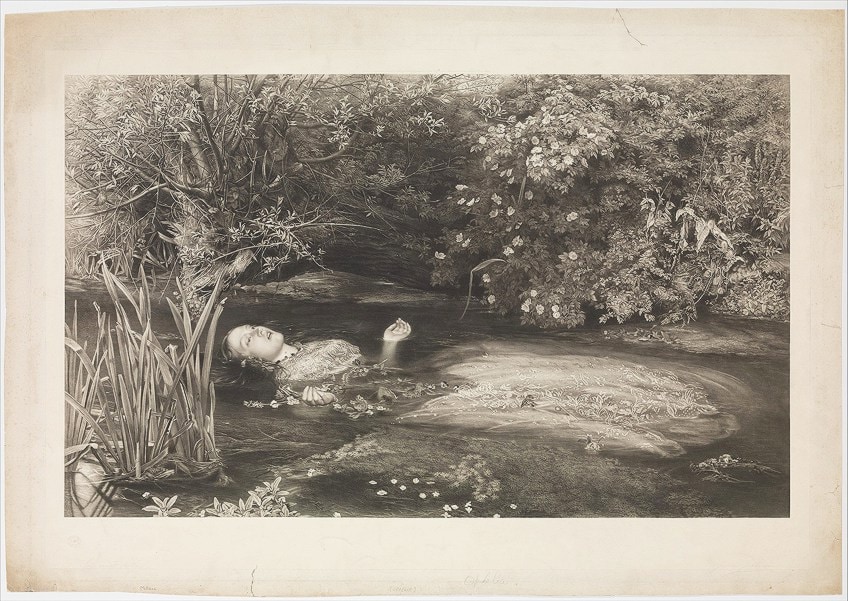
Shakespeare, Flowers, and Real Life
Hamlet was one of William Shakespeare’s most famous plays, the phrase by Hamlet’s character, “to be, or not to be” is emblazoned on the pages of history, but the character known as Ophelia, who turned mad and drowned in a brook, became a popular choice for subject matter throughout the Victorian era, and although she met a tragic end, she was the star of many paintings.
Interestingly, in Shakespeare’s play, Ophelia’s death was not depicted, but described by the character Queen Gertrude when she spoke to Laertes, who was Ophelia’s brother in Act 4, Scene 7.
Queen Gertrude explained how Ophelia tried to climb a willow tree to pick flowers, but she fell into the “weeping brook” when an “envious sliver broke” (a branch); her clothes kept her afloat only for a short while and she sang, “which time she chanted snatches of old tunes” but eventually “her garments, heavy with their drink” caused her to sink down to her “muddy death”.
It is important to note that Ophelia was also closely associated with flowers, and certain flowers held symbolic meanings. There were also several types of flowers mentioned in the play when Queen Gertrude described the natural setting where Ophelia died, explaining: “therewith fantastic garlands did she make of crow flowers, nettles, daisies, and long purples”. John Everett Millais depicted some of these flowers in the Ophelia painting, which we will explore in the visual description below, but he also depicted the flowers and foliage from the Hogsmill River and its bank.
It is important to note that the flowers were significant during the Victorian era, holding various symbolic meanings.
Formal Analysis: A Brief Compositional Overview
Below we will look at the visual composition of Ophelia by John Everett Millais, starting with a description of the subject matter and then how the artist created it in terms of color, texture, line, shape, form, and space.
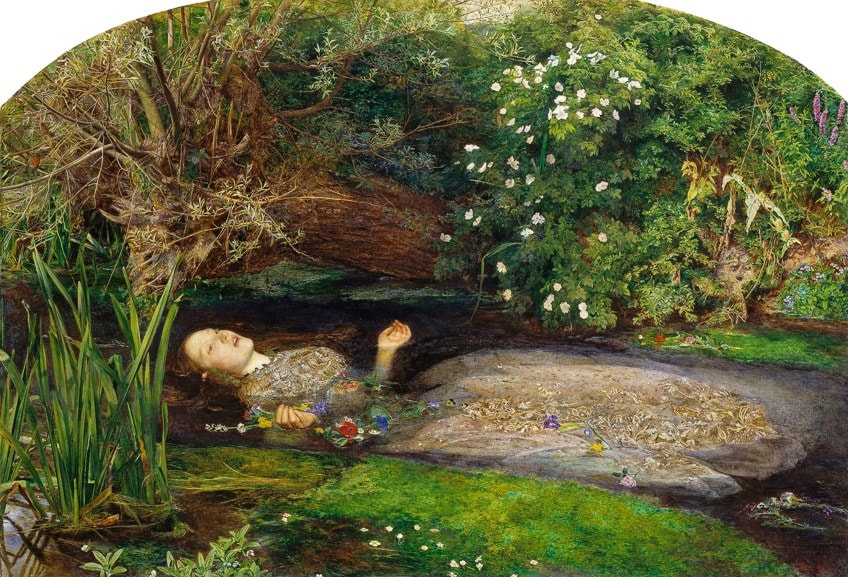
Subject Matter: Visual Description
The Ophelia painting needs to be viewed from far away, to see the entire image, and from up close, to not only see but experience the minute detail. The composition is depicted in a horizontal orientation, and the main protagonist and focal point, Ophelia, is floating in a body of water. Her head is situated to the left of the composition, and her feet face towards the right-hand side.
She is depicted in a beautiful, soft dress barely keeping her buoyant and her midsection is submerged in the water.
Her face is still out of the water, and we can see she has an almost listless expression; her eyes are staring out ahead and her mouth is slightly parted. She appears almost unaware of the fact that she is drowning (“As one incapable of her own distress”), and she is still singing, as per Queen Ophelia’s description of her in Hamlet (Act 4, Scene 7), which was mentioned earlier in the article.
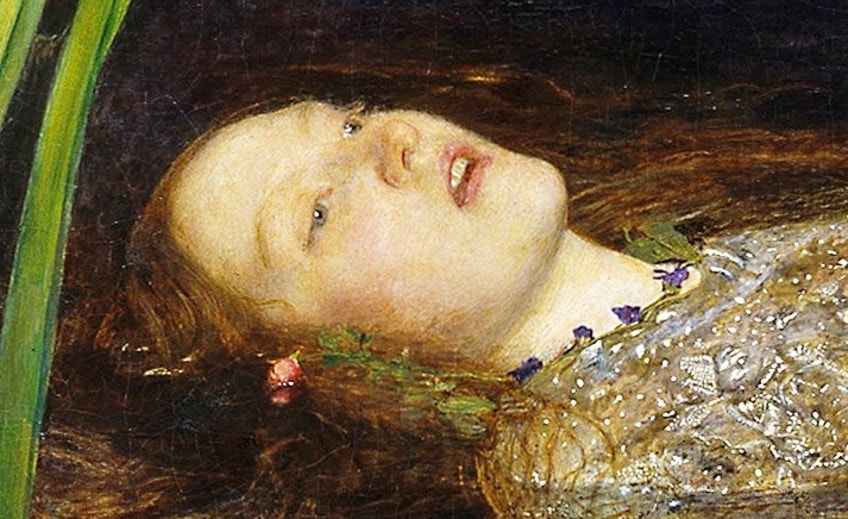
There is a necklace of purple violets around her neck and a small pink rosebud on its stem near her right ear. Both of Ophelia’s hands are floating just above the water, her palms are facing up and her hands appear cupped.
She is holding several flowers in her right hand (our left) and her left (our right) hand is empty.
There are also several other flowers like a red poppy, daisies, a deep violet/blue cornflower, white jasmine, pansies, marsh marigolds, a cabbage rose, Irises, fritillaries, and more floating down the water’s current, mostly along Ophelia’s right side (our left).

Lush foliage surrounds the almost drowned figure of Ophelia. To the left of the composition is a large tree stump of a weeping willow with various branches and stinging nettle growing around it. In the top left corner, atop one of the thin branches, is a robin.
The robin bird holds significant symbolism, including rebirth and death.
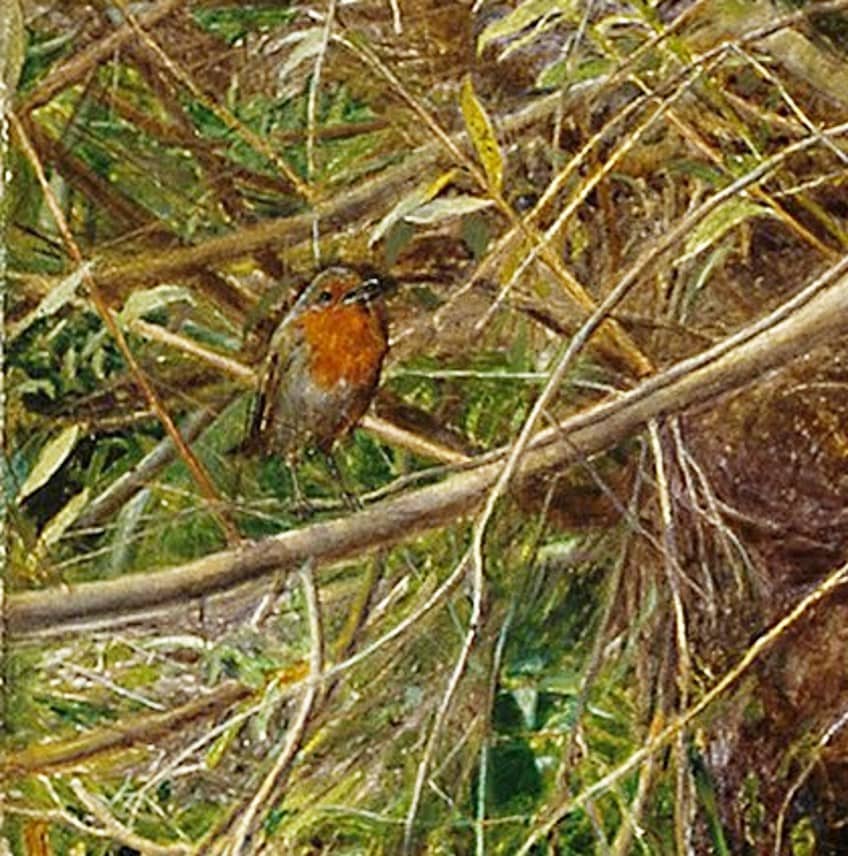
To the right of the composition is more greenery and an assortment of plants. There is a briar rose bush with white blooms more towards the middle background, and to its left (our right) are either the teasel flowering plant or meadowsweet flowers.
In the top right corner is another plant with purple flowers, which could possibly be the “purple loosestrife”, and directly below it are forget-me-nots on the embankment.
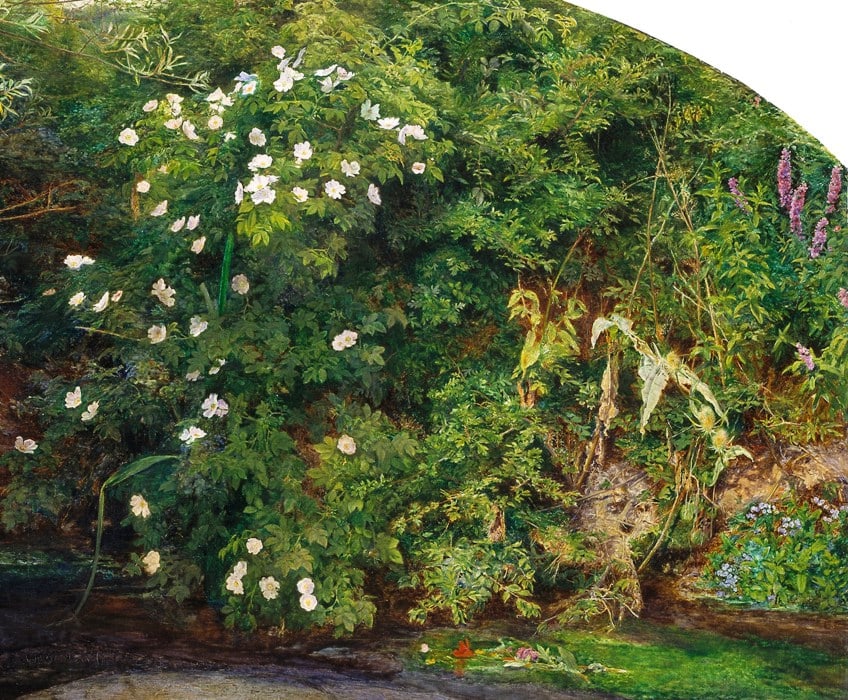
In the foreground, in the bottom left corner, is a plant with vertical strips of leaves (referred to as “monocot” leaves), possibly the greater pond sedge, and just in front of it – in the near foreground – are forget-me-not flowers.
Towards the middle foreground is a mossy/algae patch with small white flowers growing from it, which could be “stream water crowfoot”.

Color
The dominant colors in Ophelia by John Everett Millais are varieties of greens, however, Millais utilized different yellows, blues, whites, and blacks. He utilized a “lush” mixture of hues to create the tonal contrasts of color, especially between the darker shadier parts of the foliage and the lighter parts illuminated by natural light. There are also other colors from the various flowers, providing more variety as well as enhancing the subject matter and symbolic meanings.
Furthermore, Ophelia’s skin tone is depicted as fair and light, contrasted against the deep dark colors of the water below her.
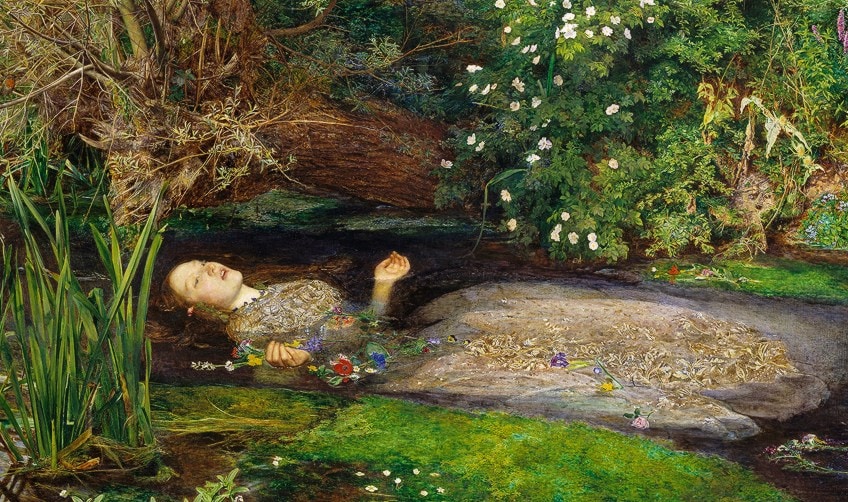
Texture
John Everett Millais painted so close to nature that you would think the Ophelia painting is a photograph. As rich as it is in the foliage and flowers of the natural landscape, so too is it in implied texture, which gives the illusion of the tactile appearance of the subject matter.
For example, the monocot leaves from the sedge plant in the bottom left foreground. Notice the broken tip of one of the leaves and the overall smoothness, upright firmness, yet soft flexibility.
Other examples include Ophelia’s diaphanous dress billowed by the water below and around her, which appears soft and silky with a slightly rougher texture created by the embroidery on it. Another rough texture is implied by the willow tree’s furrowed bark and a seemingly slimy texture of the algae in the water in the foreground.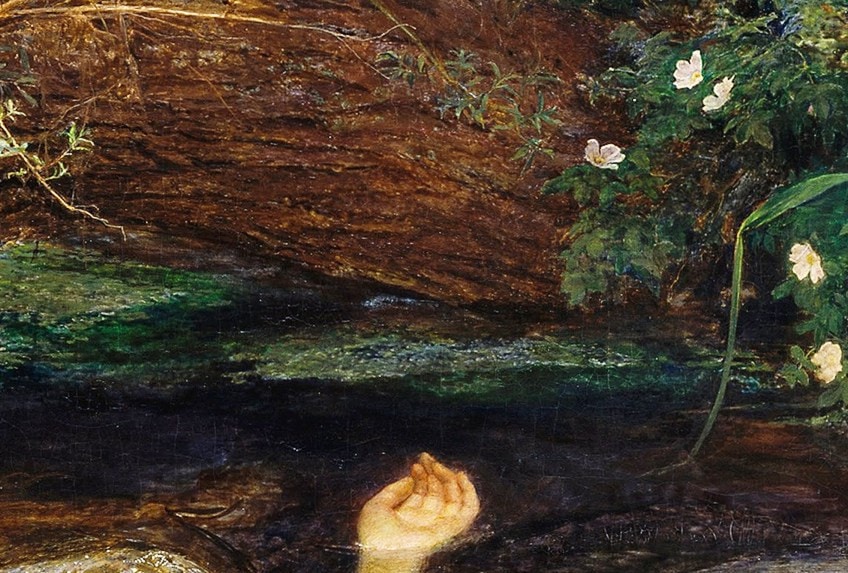
Line
There is a diversity of lines in Ophelia by John Everett Millais, from the vertical lines created by the Sedge plant in the lower left foreground to the diagonal lines from the various branches and twigs of the willow tree to the left, including the tree stump.
The orientation of the composition itself is landscape, which creates an overall horizontal linearity, emphasized by Ophelia’s placement in the scene; her body and the part of the stream she floats in both create a horizontal band running through the center of the canvas.
The orientation of the composition itself is landscape, which creates an overall horizontal linearity, emphasized by Ophelia’s placement in the scene; her body and the part of the stream she floats in both create a horizontal band running through the center of the canvas.

Shape and Form
The Ophelia painting depicts organic shapes and forms that are found in nature versus geometric shapes and forms. These include a variety, from the diamond-like and oval shapes of the leaves to the circular and patterned shapes of the flowers. Additionally, there is also the long rectangular shape created by the horizontal body of water, while the willow tree stump has a seemingly rounded rectangular shape as it juts out from the foliage and above the water.
However, these shapes are not distinctively outlined or geometric; instead, they blend into the natural environment.
Space
Space as an element of art refers to the “area” utilized in the composition as well as the level of three-dimensionality or depth to create perspective. This can also be conveyed through various other elements like color, shapes, and the scale of objects, as well as how much detail is depicted, which is noticeable in Millais’s Ophelia painting. In the Ophelia painting, the vegetation in the foreground and background creates a framing effect, which places our, the viewers, attention on Ophelia in the center.
Furthermore, the background of the composition acts almost as a backdrop of fauna and flora, which brings Ophelia’s figure closer into our space, also making the picture space shallower.
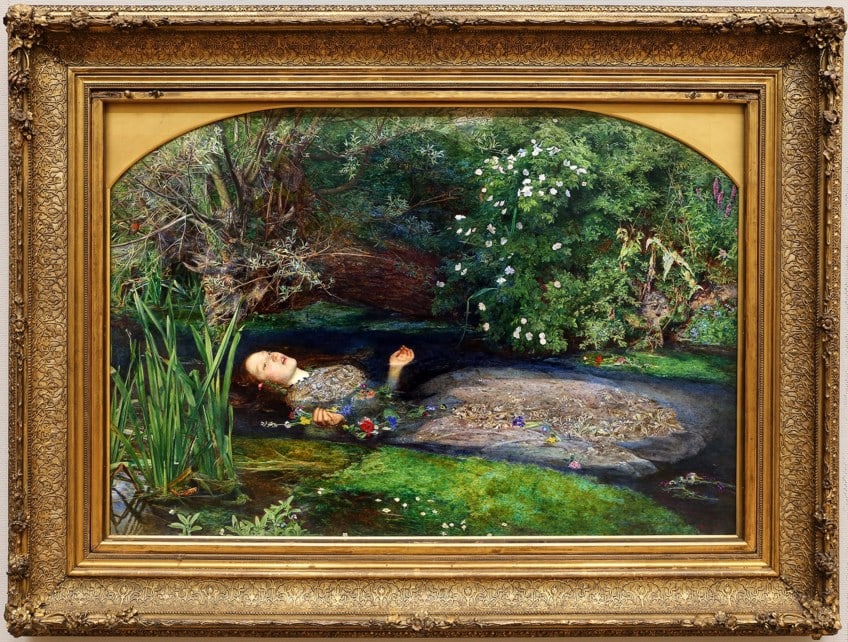
Ophelia: Death, Beauty, and Botany
Ophelia by John Everett Millais has invited many a discourse, from feminism and how women are depicted in art, their role in a patriarchal society, and Ophelia herself as the subject for many paintings during the 19th century, to the Victorian era’s penchant for flowers, their significance, and symbolic meanings.
Alongside its appearances in pop culture like film, television, and music, the “Ophelia” painting has influenced modern artists like the Surrealist Salvador Dalí, who also produced an iteration of the scene titled “Ophelia’s Death” (1973). The “Ophelia” painting has been a botanist’s beacon for identifying flowers and plants as well as a tale of death and how Ophelia met her demise surrounded by the ever-beautiful bouquets of flowers.
Take a look at our Ophelia painting webstory here!
Frequently Asked Questions
Who Made the Famous Ophelia Painting?
The famous Ophelia (1851–1852) oil-on-canvas was painted by John Everett Millais, who was part of the pre-Raphaelite Brotherhood art group, and one of its founders. The painting depicts the moment Ophelia is about to drown, surrounded by a myriad of flowers symbolizing aspects of what she experienced, from life and love to death.
What Story Is the Ophelia Painting Based On?
Ophelia (1851–1852), painted by John Everett Millais, was based on the character from William Shakespeare’s famous play Hamlet (c. 1599–1601). It depicts the scene of Ophelia’s death described by Queen Gertrude in Act 4, Scene 7.
What Does the Ophelia Painting Symbolize?
The painting Ophelia (1851–1852) by John Everett Millais explores several themes, from death, love, life, madness, and nature. There are numerous flowers depicted and each holds symbolic meanings that relate to the themes of the story, which is based on the play Hamlet (c. 1599–1601) by William Shakespeare.
Alicia du Plessis is a multidisciplinary writer. She completed her Bachelor of Arts degree, majoring in Art History and Classical Civilization, as well as two Honors, namely, in Art History and Education and Development, at the University of KwaZulu-Natal, South Africa. For her main Honors project in Art History, she explored perceptions of the San Bushmen’s identity and the concept of the “Other”. She has also looked at the use of photography in art and how it has been used to portray people’s lives.
Alicia’s other areas of interest in Art History include the process of writing about Art History and how to analyze paintings. Some of her favorite art movements include Impressionism and German Expressionism. She is yet to complete her Masters in Art History (she would like to do this abroad in Europe) having given it some time to first develop more professional experience with the interest to one day lecture it too.
Alicia has been working for artincontext.com since 2021 as an author and art history expert. She has specialized in painting analysis and is covering most of our painting analysis.
Learn more about Alicia du Plessis and the Art in Context Team.
Cite this Article
Alicia, du Plessis, ““Ophelia” by John Everett Millais – The Tragic Story of Ophelia.” Art in Context. October 8, 2022. URL: https://artincontext.org/ophelia-by-john-everett-millais/
du Plessis, A. (2022, 8 October). “Ophelia” by John Everett Millais – The Tragic Story of Ophelia. Art in Context. https://artincontext.org/ophelia-by-john-everett-millais/
du Plessis, Alicia. ““Ophelia” by John Everett Millais – The Tragic Story of Ophelia.” Art in Context, October 8, 2022. https://artincontext.org/ophelia-by-john-everett-millais/.


